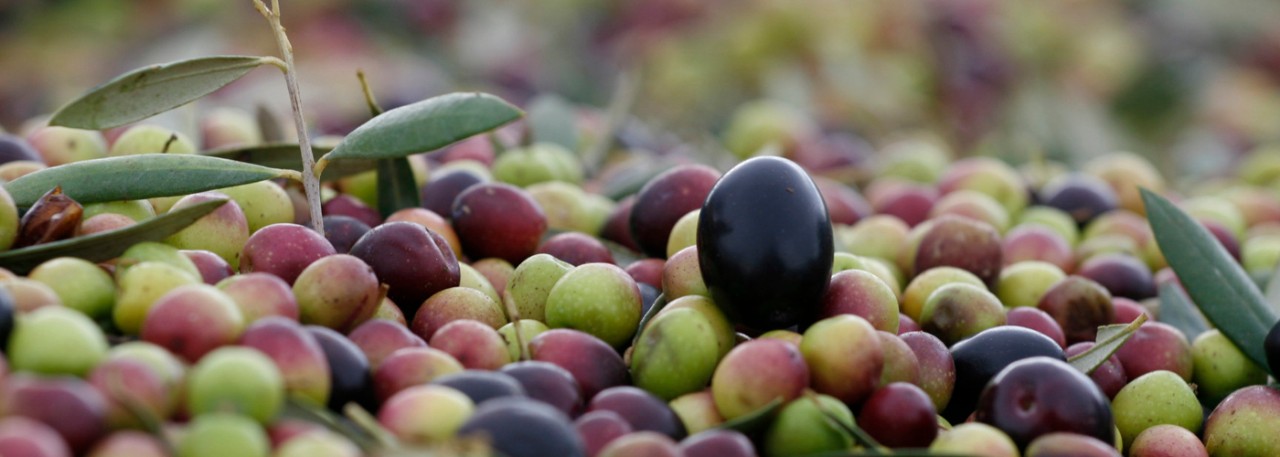.png.transform/rendition-xs/image_image%20(1).png)
Aceite de Navarra PDO
Extra virgin olive oil obtained from olives harvested from the following varieties of trees: ‘Arróniz’, ‘Empeltre’ and ‘Arbequina’. The main variety is considered to be the native variety of ‘Arróniz’, comprising over 10% of the coupage of the oil, giving it a distinctive character.
Tasting Notes
The oils are well balanced and complex, with medium-to-strong fruitiness (>4.5), green notes, and a distinctive but balanced bitterness and spiciness, mild to medium intensity but not sweet.
Other Notes
- The oils have a high percentage of oleic acid (over 72%).
- Acidity: maximum 0.3%
Production / Processing method
Growing olive trees:
Fruit is harvested exclusively by obtaining the olives directly from the tree using traditional methods of picking by hand, beating or vibration, with blankets placed on the ground under the trees to prevent the olives coming into contact with the ground and being damaged. Harvesting machines may also be used. Harvesting is done at any time between October and mid-February, starting with ‘Arbequina’ and ending with ‘Arroniz’, with fruit normally collected at a degree of ripeness of between 3.5 and 4 except for the ‘Arbequina’ variety, which is harvested when greener. To prevent the fruit sticking together, the olives are crushed within a maximum period of 48 hours after harvesting.
Obtaining the oil:
Processing and packaging plants generally work on a continuous system, with very few differences in processing, selection and extraction of the oil. The mills most commonly used are hammer mills and they are usually located in a separate but adjoining area to where the equipment for extracting the oil from the paste is installed.
The preparation stages involved in making extra virgin olive oil are the following: crushing, beating the paste, cold pressing at a temperature no higher than 30ºC, centrifuge, decanting and cellar storage. The processed oil is taken to decanting tanks and following the decanting process, it is moved to storage tanks. The processed oil is stored inside the plant, in stainless steel tanks.
Packaging and sale:
The packaging process must take place in the protected geographical area, since the oil continues to develop. Packaging must therefore be regarded as the last stage in the production process and is crucial to protecting the quality and characteristics of the protected oil.
Geography / Relief and climate
In Navarre the northern edge of the olive plantation area marks so-called Mediterranean Navarre, almost all of which lies in the Ebro river basin, at altitudes below 600 m.
Soils are moderately deep to deep, and are dark, chalky and carbonated. Rainfall is scarce and does little to reduce the chalkiness of the land.
The climate is influenced by the Mediterranean, with dry, sunny weather and sharp contrasts in day and night temperatures during the olive ripening period, with an average of more than 120 clear days per year, mainly due to the prevailing northwesterly wind, known as the "cierzo", making it colder in winter and drier in the summer. The area is free of frost for 190 days per year and the first autumn frosts tend to occur in the second fortnight of October.
Regulatory Council
The Institute for Agrifood Technology and Infrastructures of Navarre (INTIA)
Avd. Serapio Huici, 22 - Edificio Peritos
31610 Villava (Navarra)
Tel: (+34) 948 013 045
cdolado@intiasa.es
www.denominacionesnavarra.com
Sources:
- Spanish Ministry of Agriculture
- The Institute for Agrifood Technology and Infrastructures of Navarre (INTIA)
Harvesting is done at any time between October and mid-February, starting with ‘Arbequina’ and ending with ‘Arroniz’.


- Aceite de Navarra 1
- Aceite de Navarra 2

Villava (Navarre)
